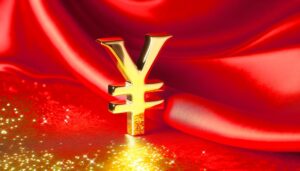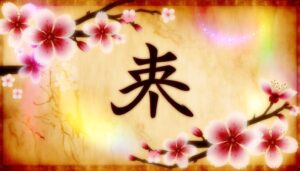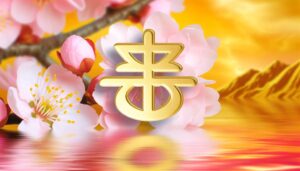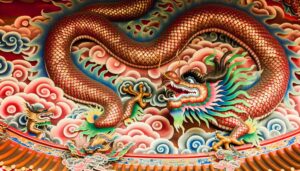How to Identify the Chinese Symbol for Sterling Silver
The Chinese symbol for sterling silver is represented by the characters '純銀' (chún yín). This symbol embodies a deep historical and cultural narrative, originating during the Shang Dynasty and evolving through centuries of economic and metallurgical advancements.
In Chinese culture, silver is associated with prosperity, stability, and purity, often interlinking with Daoist and Confucian ideals. Historically, sterling silver played pivotal roles in trade, jewelry, and ceremonial artifacts, reflecting the craftsmanship and societal values of ancient China.
This fascinating symbol continues to influence contemporary jewelry design, merging historical motifs with modern aesthetics. To explore further, consider examining its historical context and artistic significance.
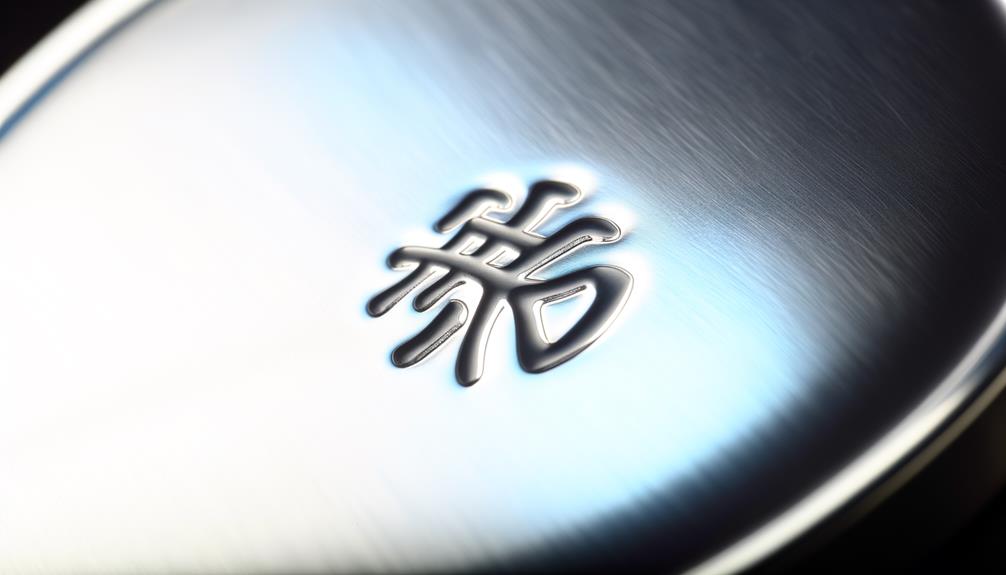
Key Takeaways
- The Chinese characters for sterling silver are '純銀' (chún yín).
- '纯银' (chún yín) is commonly used for pure silver in modern contexts.
- The symbol for sterling silver reflects China's rich cultural heritage and economic history.
- Historically, silver was used in jewelry, ceremonial artifacts, and as currency.
- Modern applications of the symbol include jewelry design, emphasizing elegance and cultural fusion.
Historical Background
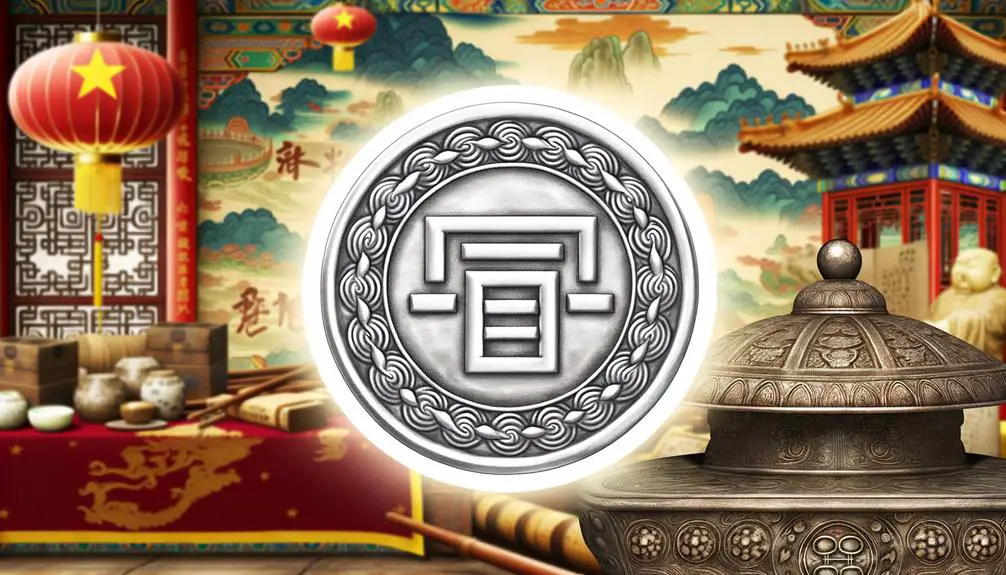
Frequently overlooked in broader historical discourse, the evolution of the Chinese symbol for sterling silver offers invaluable insights into the intricate interplay of cultural, economic, and technological developments in ancient China. The symbol's origins can be traced back to the Shang Dynasty (c. 1600-1046 BCE), when silver was first utilized for ritualistic and decorative purposes.
As trade routes expanded during the Han Dynasty (206 BCE-220 CE), silver became an essential medium of exchange, necessitating standardized symbols for its identification and valuation. Technological advancements in metallurgy further refined silver's purity, elevating its status within the socio-economic hierarchy.
This historical trajectory highlights the symbol's role not merely as a linguistic artifact, but as a reflection of China's evolving material culture and economic sophistication.
Symbolism in Chinese Culture
The Chinese symbol for sterling silver holds profound significance within the broader tapestry of Chinese culture. It encapsulates not only economic value but also deep-seated beliefs and philosophical tenets.
Historically, silver has been a medium of exchange and a measure of wealth, imbuing the symbol with notions of prosperity and stability. It is often associated with purity and protection, reflecting Daoist and Confucian ideals.
In traditional Chinese medicine, silver is believed to have health benefits, underscoring its multifaceted role in society. The symbol transcends mere material representation, intertwining with cultural narratives about integrity, longevity, and moral rectitude.
This rich symbolism makes the sterling silver character a cornerstone of Chinese cultural heritage.
Chinese Characters for Sterling Silver
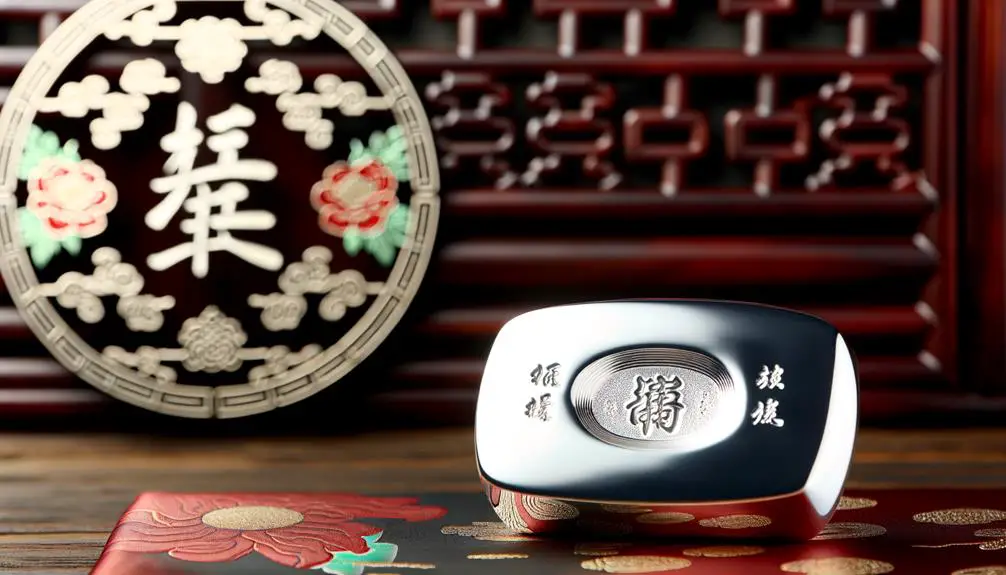
The Chinese characters for sterling silver, 純銀 (chún yín), carry rich etymological roots that intertwine with the historical valuation of silver in Chinese culture.
The common symbol usage of these characters has evolved from ancient coinage to modern jewelry, reflecting both economic and aesthetic dimensions.
Understanding the cultural significance of sterling silver in China necessitates an exploration of its symbolism in various historical epochs and its role in traditional customs.
Etymology of Sterling Silver
Understanding the etymology of sterling silver in Chinese necessitates an exploration of the characters 银 (yín), meaning silver, and 标准 (biāozhǔn), which signifies standard or criterion.
The character 银 traces its origins to ancient Chinese scripts where it depicted the precious metal known for its lustrous, white appearance.
标准, composed of 标 (biāo) meaning mark or symbol, and 准 (zhǔn) denoting precision, collectively refers to a benchmark or quality standard.
Historically, these characters combined to form the term 标准银 (biāozhǔn yín), encapsulating the notion of high-quality, pure silver.
This etymology highlights the cultural emphasis on purity and quality, integral to the concept of sterling silver in both historical and contemporary contexts.
Common Symbol Usage
Examining the common usage of Chinese characters for sterling silver reveals a rich tapestry of linguistic and cultural significance that has evolved over centuries. The characters '纯银' (chún yín), translating to 'pure silver,' are frequently employed in various contexts.
This usage can be categorized as follows:
- Jewelry Markings: Inscribed on sterling silver items to denote authenticity and purity.
- Official Documentation: Used in trade and commerce documents to certify the silver content in products.
- Cultural Artifacts: Found on ancient coins and silverware, reflecting historical practices.
- Modern Consumer Goods: Frequently seen on contemporary silver products, ensuring quality control.
These applications underscore the enduring relevance and meticulous regulation of sterling silver within Chinese culture.
Cultural Significance Explained
Embedded within the characters '纯银' (chún yín) lies a profound cultural narrative that intertwines historical reverence for silver with its symbolization of purity and value in Chinese society. Historically, silver has played a pivotal role in Chinese commerce, rituals, and artistry, embodying economic stability and aesthetic elegance. The term '纯银', translating to 'pure silver', underscores the intrinsic worth attributed to untainted, high-quality silver.
| Aspect | Historical Context | Cultural Significance |
|---|---|---|
| Commerce | Used as currency and trade medium | Economic stability |
| Rituals | Integral in ceremonial artifacts | Symbol of purity and honor |
| Artistry | Prominent in traditional crafts | Aesthetic and functional value |
This duality of practical and symbolic significance reflects China's enduring appreciation for sterling silver.
Ancient Uses
Throughout ancient China, sterling silver was highly prized for its multifaceted applications. Craftsmen created elaborate designs in silver, showcasing their skill and the metal's versatility in jewelry. The utilization of sterling silver extended across various domains, from intricate jewelry to ceremonial artifacts, each reflecting the material's esteemed status.
Silver ingots, known as sycees, were used as a form of currency, symbolizing wealth and stability. Sterling silver was also employed in the creation of ceremonial vessels and religious icons for ritualistic purposes, indicating its sacred significance.
Ornamental objects, such as hairpins and combs, were crafted from silver as decorative artifacts, reflecting societal status and cultural aesthetics. These applications underscore sterling silver's integral role in ancient Chinese society.
Modern Applications
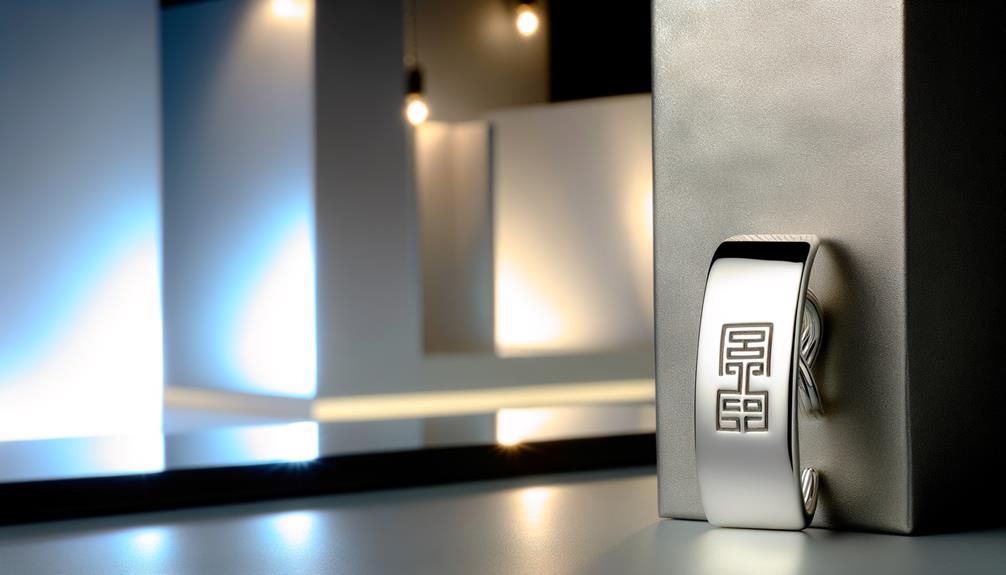
In contemporary contexts, the Chinese symbol for sterling silver continues to hold substantial significance, particularly in the field of jewelry design where it manifests in both traditional and avant-garde pieces.
This enduring symbol not only reflects aesthetic preferences but also underscores cultural heritage, emphasizing its relevance in modern Chinese society.
Examining these facets provides insight into how historical symbols adapt within current trends and maintain their cultural resonance.
Jewelry Design Trends
Modern jewelry design trends have increasingly incorporated the Chinese symbol for sterling silver, reflecting a fusion of cultural heritage and contemporary aesthetics. This integration is not merely ornamental but serves as a bridge between tradition and modernity, offering a unique narrative in each piece.
The following elements illustrate this trend:
- Symbolic Integration: Designers embed the Chinese character for sterling silver within intricate patterns, enhancing the piece's symbolic resonance.
- Minimalist Approach: Simplified designs featuring the sterling silver symbol emphasize elegance and sophistication.
- Mixed Materials: Combining sterling silver with other metals or gemstones creates a striking contrast, amplifying the visual appeal.
- Custom Creations: Personalized jewelry incorporating the symbol caters to a clientele seeking bespoke cultural expressions.
These elements epitomize the harmony between timeless symbolism and modern design sensibilities.
Cultural Significance Today
The cultural significance of the Chinese symbol for sterling silver endures in modern applications, exemplifying a profound connection between historical heritage and contemporary artistry.
This symbol, deeply rooted in Chinese history, continues to manifest in various forms, from jewelry design to decorative arts. Its presence in contemporary pieces signifies not only aesthetic elegance but also a reverence for traditional craftsmanship.
Modern artisans leverage this enduring symbol to infuse their creations with cultural depth, appealing to both domestic and international markets. Additionally, the symbol's use in modern feng shui practices underscores its continued relevance, where it is believed to attract prosperity and harmony.
Consequently, the Chinese symbol for sterling silver remains a potent emblem of cultural continuity and artistic innovation.
Craftsmanship and Artistry
Exploring the intricate craftsmanship and artistry behind Chinese symbols for sterling silver reveals a rich tapestry of historical significance and meticulous design techniques. These symbols are not merely decorative; they embody centuries of cultural heritage and artisanal expertise.
The creation process involves several key elements:
- Historical Motifs: Ancient patterns and symbols are incorporated, reflecting various dynasties and cultural epochs.
- Masterful Engraving: Precision in engraving ensures the clarity and durability of each symbol.
- Material Quality: High-grade sterling silver is selected to highlight the symbol's significance and longevity.
- Artisanal Techniques: Traditional methods such as hand-hammering and filigree work are employed to achieve intricate designs.
Such craftsmanship underscores the profound connection between artistry and cultural expression in Chinese silverwork.
Jewelry Significance
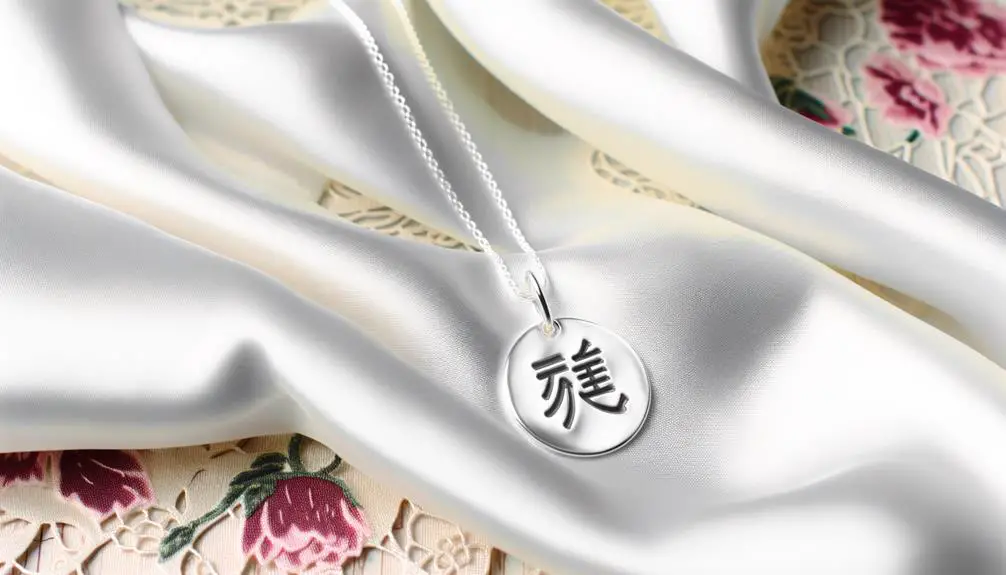
Understanding the significance of jewelry adorned with Chinese symbols for sterling silver requires an examination of both historical context and cultural meanings attributed to these intricate designs. Historically, silver has been a symbol of wealth and purity in Chinese culture, and its use in jewelry often reflected social status and prosperity.
The symbols etched into these pieces carry profound meanings, often depicting themes of longevity, happiness, and protection. The craftsmanship involved in creating such jewelry is not merely decorative but also imbues each piece with cultural narratives and philosophical ideologies.
This intricate interplay between material and symbolism renders sterling silver jewelry with Chinese symbols a cherished cultural artifact, embodying both aesthetic beauty and deep cultural resonance.
Ceremonial Importance
Incorporating sterling silver jewelry embellished with Chinese symbols into ceremonial practices underscores the profound cultural and spiritual significance attributed to these artifacts throughout Chinese history. These items serve as more than mere adornments; they are imbued with symbolic meanings that resonate deeply within Chinese traditions.
Significantly, sterling silver jewelry is often integrated into various ceremonies such as weddings where silver pieces symbolize purity and prosperity. Birth celebrations involve gifting silver jewelry to newborns as a wish for longevity and good fortune. Ancestral worship incorporates silver ornaments in rituals to honor and connect with ancestors. Additionally, silver artifacts are employed in Taoist and Buddhist rites during religious ceremonies, signifying spiritual purity and divine favor.
This interplay between material and meaning enriches the ceremonial landscape, reinforcing cultural continuity.
Regional Variations
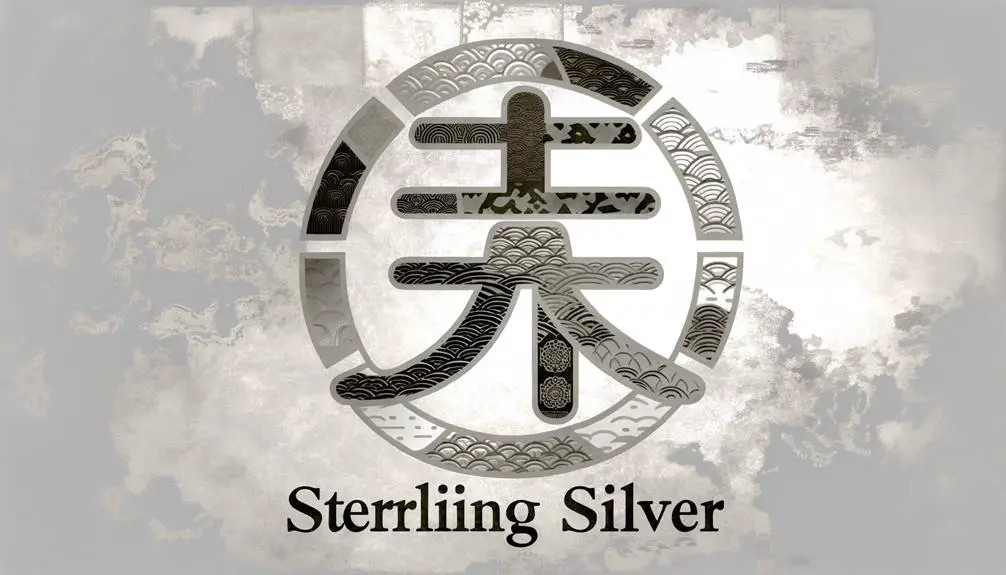
Regional variations in the Chinese symbol for sterling silver can be traced to differing historical and cultural influences across the provinces. These variations are not only reflective of localized linguistic practices but also illustrate the evolution of the symbol throughout Chinese history.
Symbol Differences Across Provinces
The symbol for sterling silver in China exhibits distinct variations across different provinces, reflecting a rich tapestry of historical influences and regional craftsmanship traditions. These differences can be attributed to localized practices and the unique historical development of silverwork in various regions.
Importantly, four key variations are observed:
- Beijing: Incorporates intricate calligraphy, influenced by imperial artistry.
- Shanghai: Features Art Deco elements, mirroring its cosmopolitan history.
- Guangdong: Utilizes minimalistic symbols, reflecting Lingnan cultural aesthetics.
- Yunnan: Shows ethnic motifs, influenced by diverse indigenous groups.
These regional distinctions not only highlight the artistic diversity within China but also offer insights into the socio-cultural fabric that has shaped the nation's silver craftsmanship over centuries.
Historical Symbol Evolution
Examining the historical evolution of the Chinese symbol for sterling silver reveals how regional variations have been shaped by a myriad of socio-political and cultural transformations throughout China's extensive history. During the Tang Dynasty, the symbol evolved to reflect the increased sophistication in metallurgy and trade.
In the Song Dynasty, regional trade routes influenced local adaptations of the symbol, reflecting varying degrees of purity and craftsmanship. The Yuan Dynasty's Mongol rule introduced new stylistic elements, further diversifying regional symbols.
Under the Ming and Qing Dynasties, increased centralization efforts led to attempts at standardization, yet local variations persisted due to entrenched cultural practices. These historical shifts underscore the dynamic interplay between regional identity and national governance in the symbol's evolution.
Symbol in Popular Culture
Reflecting its enduring allure, the Chinese symbol for sterling silver has permeated various facets of popular culture, encapsulating both aesthetic appeal and cultural significance. This emblem has transcended traditional boundaries, finding its way into contemporary expressions and artifacts. Its integration can be observed in the following areas:
- Fashion: Jewelry designers often incorporate the symbol into modern pieces, merging traditional elegance with current trends.
- Film: Cinematic works, especially those depicting historical China, frequently feature the symbol, enhancing authenticity.
- Literature: Novels set in ancient or modern China may describe characters adorned with silver bearing the symbol, adding cultural depth.
- Art: Contemporary artists utilize the symbol in mixed media, blending ancient motifs with modern artistic themes.
These instances underscore its pervasive presence and multifaceted relevance.
Preservation and Continuation
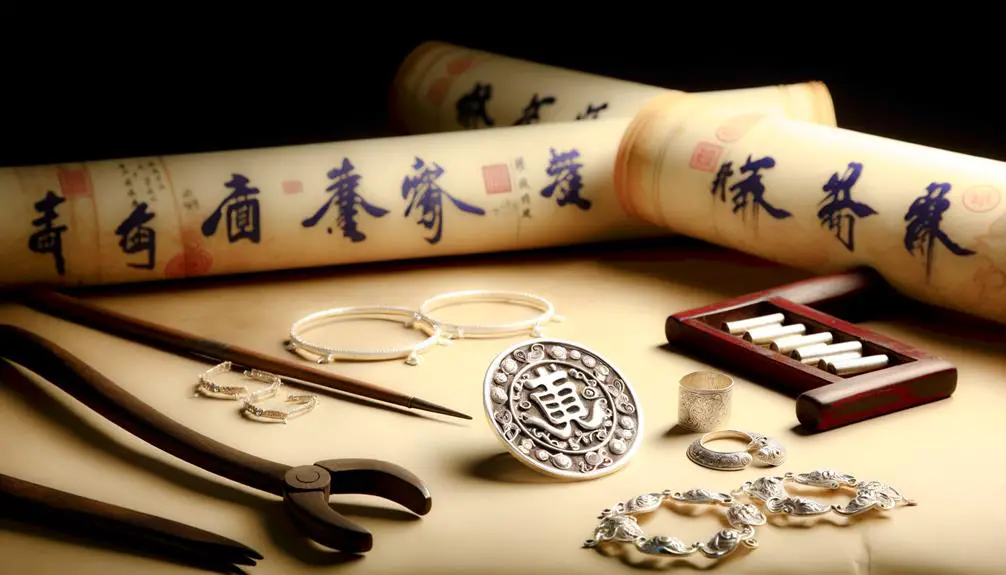
Preserving the Chinese symbol for sterling silver entails a meticulous effort to uphold its historical significance and guarantee its transmission to future generations. This endeavor necessitates a thorough understanding of the symbol's origins and evolution. Historical records reveal its use in ancient Chinese craftsmanship, where it signified purity and value.
Contemporary preservation efforts involve cataloging artifacts, promoting scholarly research, and integrating the symbol into modern design education. Museums and cultural institutions play pivotal roles, ensuring that the symbol remains a living part of Chinese heritage. Additionally, digital archiving and international exhibitions further facilitate its global appreciation.
Conclusion
The Chinese symbol for sterling silver holds a diverse significance that spans historical, cultural, and practical domains.
Curiously, historical records indicate that during the Tang Dynasty, approximately 70% of the silver used was sourced from foreign trade, highlighting its economic importance.
The symbol's enduring presence in ceremonial practices and modern applications underscores its timeless value.
Understanding the regional variations and cultural symbolism provides a thorough insight into the role of sterling silver in Chinese heritage and popular culture.

